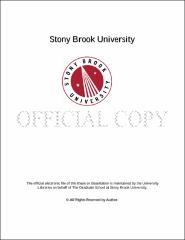| dc.identifier.uri | http://hdl.handle.net/11401/76297 | |
| dc.description.sponsorship | This work is sponsored by the Stony Brook University Graduate School in compliance with the requirements for completion of degree. | en_US |
| dc.format | Monograph | |
| dc.format.medium | Electronic Resource | en_US |
| dc.language.iso | en_US | |
| dc.publisher | The Graduate School, Stony Brook University: Stony Brook, NY. | |
| dc.type | Thesis | |
| dcterms.abstract | In this work, four catalysts have been studied for their photocatalytic efficiency by testing each with methylene blue dye solution. Three catalysts were synthesized by the electrospinning method and then compared with the fourth commercially available catalyst for their photocatalytic activity. The basic metal oxide studied was titanium dioxide. Nanocomposite mats of pure titania, copper doped titania and copper doped degussa P25 titania, were synthesized using the electrospinning method. The pure titania and copper doped titania nanocomposites possessed the anatase phase which was obtained by annealing the as-spun nanocomposites at 450<super>0</super>C. All the catalysts were analyzed for their photocatalytic activity both under ultra-violet light and under visible light. The aim of this work was to synthesize titania photocatalysts, demonstrate their photocatalytic activity with methylene blue solution under UV-light and visible light and compare their activities with the commercial titanium dioxide (degussa P25). It is important to synthesize visible light active photocatalysts as these could be activated under a wide spectrum of natural sunlight unlike the degussa titanium dioxide. Doping was incorporated in order to narrow the band gap energy of the photocatalyst for achieving higher efficiency especially under visible light irradiation. The morphology and size of the synthesized photocatalysts were studied by characterizing them with Scanning Electron Microscopy, Energy Dispersive X-Ray Spectroscopy, Transmission Electron Microscopy and X-Ray Diffraction. The photocatalytic activity tests were carried out using UV-Vis Spectroscopy. It was found that the electrospun pure titania and copper doped titania fibers were activated under the visible light spectrum unlike the degussa titanium dioxide. The copper doped titania provided to be the most efficient photocatalyst under visible light radiation and the importance of this finding can be extended for treating industrial wastewaters by just exposing it to natural sunlight in the presence of this photocatalyst.   | |
| dcterms.available | 2017-09-20T16:49:58Z | |
| dcterms.contributor | Venkatesh, T.A. | en_US |
| dcterms.contributor | Gouma, Perena | en_US |
| dcterms.contributor | Halada, Gary. | en_US |
| dcterms.creator | Divya, Sherlyn | |
| dcterms.dateAccepted | 2017-09-20T16:49:58Z | |
| dcterms.dateSubmitted | 2017-09-20T16:49:58Z | |
| dcterms.description | Department of Materials Science and Engineering. | en_US |
| dcterms.extent | 81 pg. | en_US |
| dcterms.format | Application/PDF | en_US |
| dcterms.format | Monograph | |
| dcterms.identifier | http://hdl.handle.net/11401/76297 | |
| dcterms.issued | 2013-12-01 | |
| dcterms.language | en_US | |
| dcterms.provenance | Made available in DSpace on 2017-09-20T16:49:58Z (GMT). No. of bitstreams: 1
Divya_grad.sunysb_0771M_11537.pdf: 1305842 bytes, checksum: 35021fe3e0bc6e316233fb61e79dd956 (MD5)
Previous issue date: 1 | en |
| dcterms.publisher | The Graduate School, Stony Brook University: Stony Brook, NY. | |
| dcterms.subject | Materials Science | |
| dcterms.title | Electrospun Mixed Oxide Photocatalysts to Decompose Dyes in Water | |
| dcterms.type | Thesis | |

